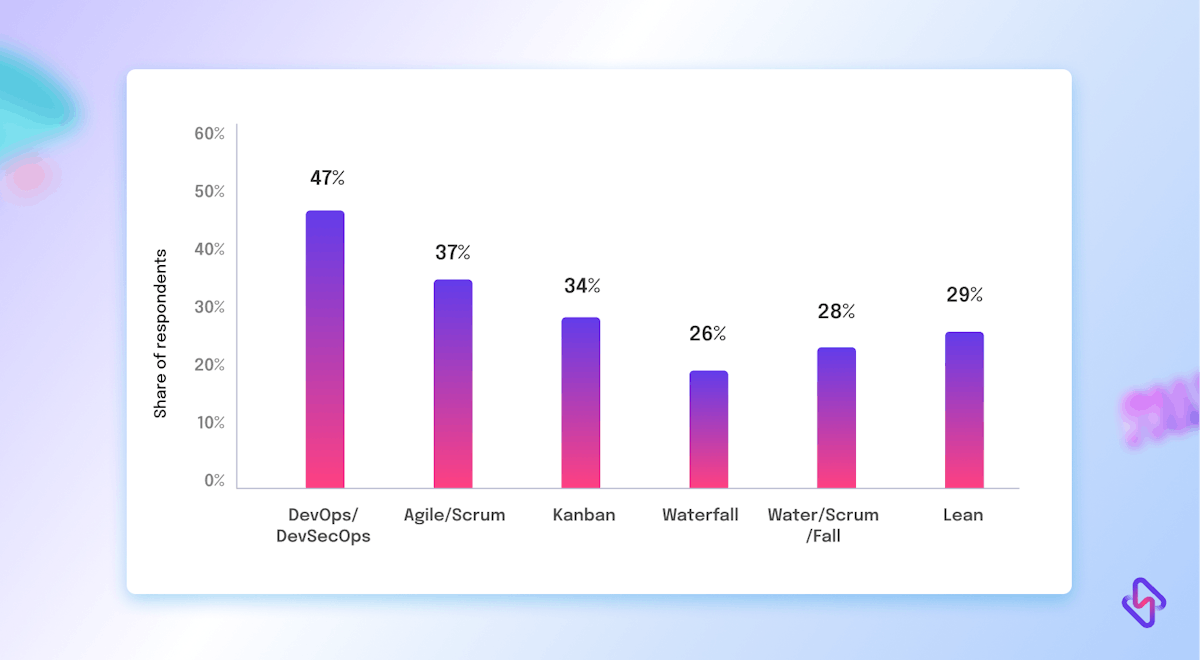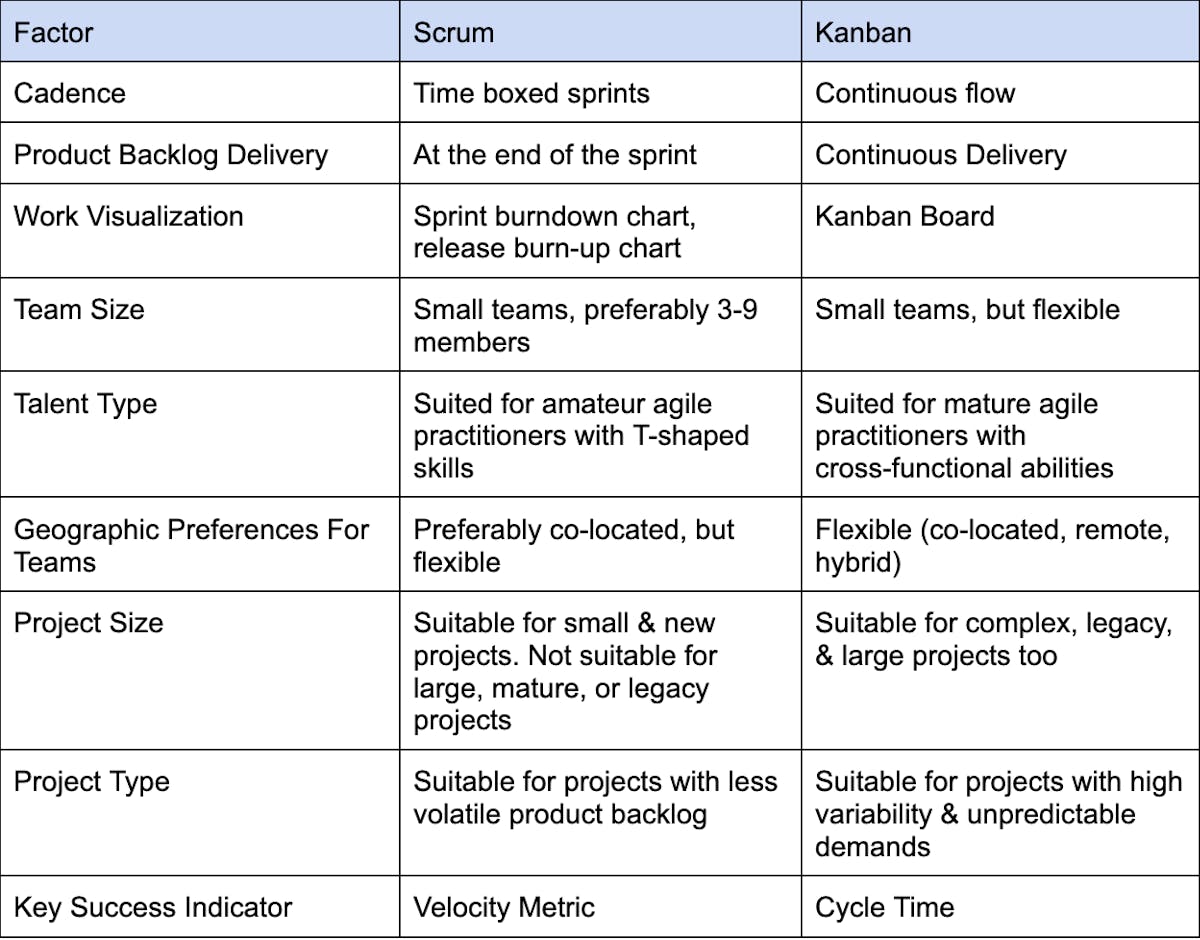Scrum, by far, is the most practiced agile software development methodology. 37% of the organization claims to be using Scrum. Here are the key aspects of the Scrum agile methodology:
- The Scrum team comprises a product owner, a Scrum master, and a couple of developers
- Scrum workflow is a collection of time-boxed sprints. Each sprint has a fixed length with a fixed deliverable goal.
- Each sprint starts with a sprint planning session, where the team decides on
“What should be the deliverable goal at the end of the sprint?”
- Post that, the developers work in a high-octane collaborative work environment to complete the backlog items undertaken as deliverables of the sprint.
- Developers organize time-boxed daily Scrum meetings, not extending beyond 15 minutes, to update the team about progress, and roadblocks, if any.
- For improved visibility & alignment, The Scrum team makes use of burndown charts (reflect remaining time & backlog items), and release burn-up charts (reflect work completed in a sprint, work added, and work pending up until the next release).
- The Sprint ends with Sprint Review & Sprint Retrospective which are aimed at identifying what could have been better and accordingly plan for the upcoming sprints.
If you wish to dive deeper into the essence of Scrum, explore the Scrum Guide. To know when to go for Scrum, read the next section.
When should you choose Scrum over other agile methodologies?
The success of Scrum Sprints is often measured in terms of goals achieved, and velocity metrics. In general, small-size, co-located teams that possess T-shape skilled individuals, would fare better in terms of velocity with the Scrum framework, especially when the frequency of changes in the backlogs is low.
Let us understand when to choose Scrum over other agile methodologies.
1. Co-located Teams
To ensure high velocity, it is helpful if developers are co-located and work under the same roof, in the same room, and maybe on the same table as well. But that doesn’t mean Scrum is not suited to remote teams. If remote teams can ensure high availability and uninterrupted digital collaboration, then Scrum is viable for remote teams as well. However, the less a Scrum team is geographically dispersed, the better it is.
2. Small Team Size
Scrum has a structured workflow to develop backlog items. Also, Scrum’s success is heavily dependent on effective collaboration and coordination. So, it is suited for projects that can be completed by a small team of 3-9 people. Ideally, for developing new software or applications, where external dependencies are minimal, and the entire SDLC processes can be handled by the Scrum team themselves including unit testing and integrations.
3. T-shaped Talent
In Scrum or Scrum-inspired agile software development methodologies like Scrumban, as team size is preferably small, individuals are often required to deal with tasks that extend beyond their core role. For example, it’s normal for a developer to be making presentations to the stakeholders. Or, you may find a front-end engineer sitting next to a back-end engineer and trying to help fix bugs.
Scrum sounds cool for small projects, but is it suited for large-size projects and legacy systems?
Nope.
Large projects often have to deal with huge technical debt, and there could be a lot of variable moving pieces, that too of varying sizes. Scrum usually suits projects that are well-defined and have a minimal influx of change requests. For large-sized projects, you can evaluate if Kanban fits the bill. Let’s find out.
Kanban — Key Characteristics
Kanban is the second most popular agile software development methodology.
- Unlike Scrum, Kanban hardly has any defined roles or responsibilities.
- Kanban agile methodology is not time bound, rather the cadence here is defined as ‘continuous flow’ i.e., just-in-time philosophy.
- Unlike scrum, Kanban teams continuously deliver backlog items (aka story points or EPICs), in contrast to delivering at the end of the sprint.
- A typical Kanban workflow involves:
undefinedundefinedundefined
- A Kanban Board is the heart of any Kanban-driven software development project. Its key utility is to help Kanban teams continuously visualize the status of backlog items, limit the work in progress i.e., the number of backlog items that are actively under development, and define acceptance policies i.e., the definition of done for features or for items to move from one column to another.
undefined
Explore Kanban in more detail here.
When should you choose Kanban over other agile methodologies?
The efficacy of the Kanban approach is often attributed to the cycle time metric and ensuring developer well-being. Kanban-driven agile software development should be the choice of project managers who have a special inclination toward developer well-being and are in charge of dynamic & market-sensitive projects.
Let us try to understand when to choose Kanban over other agile methodologies.
1. Projects with Dynamic Requirements
Kanban’s core principles are flexibility and continuous flow. And so, it is suited for projects that are unpredictable. In such projects, some features could take weeks to complete, while others may get done in a couple of days. Kanban is designed to accommodate work items with varying sizes and complexity. It can adapt to an influx of change requests, new backlog items, or changes in the priority of backlog items that are yet to move in the WIP column of the Kanban Board.
2. Cross-functional, Experienced Teams
There are no limitations imposed on the number of people working on a Kanban-driven agile software development project. Ideally, the size of the team should be enough to comply with the defined WIP policies and maintain a healthy cycle time. But Kanban is not a framework for amateur agile practitioners as it demands prowess in self-management & task ownership. For instance, teams must actively strive to avoid unnecessary expansion unless the project demands it. Compact teams also mean better collaboration and effective communication.
3. Legacy & Service-oriented Projects
Given the nature of the Kanban framework, of course, it is suited for new complex projects with mature agile practitioners working on them. But Kanban is a gem because it's appropriate for mammoth legacy projects that need incremental improvement or maintenance. Organizational culture has been quoted as one of the top challenges to agile adoption, but frameworks like Kanban have been constantly lowering the barriers and making it easier for siloed teams to be more agile and respond to the market in real time.
Scrum Vs Kanban — Can Hatica Be of Any Help?
Be it Scrum or Kanban, agile teams that continuously improve their processes will always be winning. Hatica gives you data-led insights into the health of your engineering operations & processes. It tracks 130+ engineering metrics to help you gain a deeper understanding of your engineering workflow, identify bottlenecks, and make informed decisions to resolve the same.
For instance, if you’re concerned with the performance of a Kanban team/project, Hatica can help you track cycle times, lead times, and throughput for it. Hence, allows you to monitor the flow of work and identify trends, spot inefficiencies, and make data-backed decisions to streamline your processes. Assume that your Kanban board has Product backlog, WIP, Code review, and Done columns. And consider a scenario where your cycle time is high and wait time is high too for the items in the code review stage. Then maybe, the inefficiency in the workflow is introduced by the code review team. It is an opportunity for you and the respective teams to optimize your code review processes by delving deeper into the cause and resolving it.
Similarly, for Scrum agile practitioners, Hatica might reveal why your team consistently falls short of the agreed sprint goals. It could be a pattern more frequent during certain periods or when specific types of user stories are being developed. You may further analyze individual team members’ contributions by visualizing their work completion rates, and try spotting inefficiencies in the task distribution, or in the workflow itself. The symptoms and causes may vary from one project to another, but the engineering analytics tool can always help you get to the crux of the issue by tracking individual metrics and then by looking holistically to connect the dots.
Making the Right Choice: Scrum or Kanban?
To bring the conversation full circle, the choice between Scrum and Kanban is a critical decision that can significantly impact the success of your agile software development initiatives. Scrum, with its structured sprints and emphasis on collaboration, is well-suited for small, co-located teams with stable backlogs. Kanban, on the other hand, thrives in dynamic environments, offering flexibility and continuous flow for projects with unpredictable requirements. Both these frameworks are only as good as the agile practitioners implementing them, which is prone to inefficiencies. But the good news is that you can always make use of engineering analytics tools like Hatica to spot any such inefficiencies and proactively address them for your project’s success. Here is a final tabular reflection of the key Scrum vs Kanban differences, and which of these agile methodologies should you choose.








